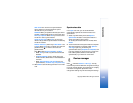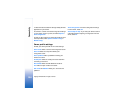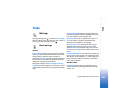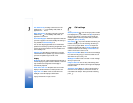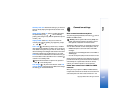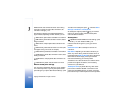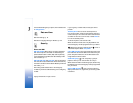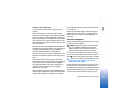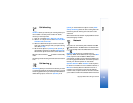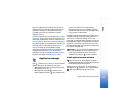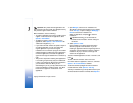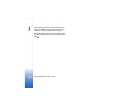
Tools
111
Copyright © 2005 Nokia. All rights reserved.
Glossary of PIN and lock codes
If you forget any of these codes, contact your service
provider.
Personal identification number (PIN) code—This code
protects your SIM card against unauthorised use. The PIN
code (4 to 8 digits) is usually supplied with the SIM card.
After three consecutive incorrect PIN code entries, the PIN
code is blocked, and you need to unblock it before you can
use the SIM card again. See the information about the PUK
code in this section.
UPIN code—This code may be supplied with the USIM card.
The USIM card is an enhanced version of the SIM card and
is supported by UMTS mobile phones. The UPIN code
protects the USIM card against unauthorised use.
PIN2 code—This code (4 to 8 digits) is supplied with some
SIM cards, and is required to access some functions in your
phone.
Lock code (also known as security code)—This code (5
digits) can be used to lock the phone to avoid unauthorised
use. The factory setting for the lock code is 12345. To
avoid unauthorised use of your phone, change the lock
code. Keep the new code secret and in a safe place
separate from your phone.
Personal unblocking key (PUK) code and PUK2 code—These
codes (8 digits) are required to change a blocked PIN code
or PIN2 code, respectively. If the codes are not supplied
with the SIM card, contact the operator whose SIM card
is in your phone.
UPUK code—This code (8 digits) is required to change a
blocked UPIN code. If the code is not supplied with the
USIM card, contact the operator whose USIM card is in
your phone.
Certificate management
Digital certificates do not guarantee safety; they are used
to verify the origin of software.
Glossary: Digital certificates are used to verify the
origin of the XHTML or WML pages and installed
software. However, they can only be trusted if the
origin of the certificate is known to be authentic.
In the certificate management main view, you can see a
list of authority certificates that are stored in your phone.
Press to see a list of personal certificates, if available.
Options in the certificate management main view
are Certificate details, Delete, Trust settings,
Mark/Unmark, Help, and Exit.
Digital certificates should be used if you want to connect
to an online bank or another site or remote server for
actions that involve transferring confidential information.
They should also be used if you want to reduce the risk of
viruses or other malicious software and be sure of the



